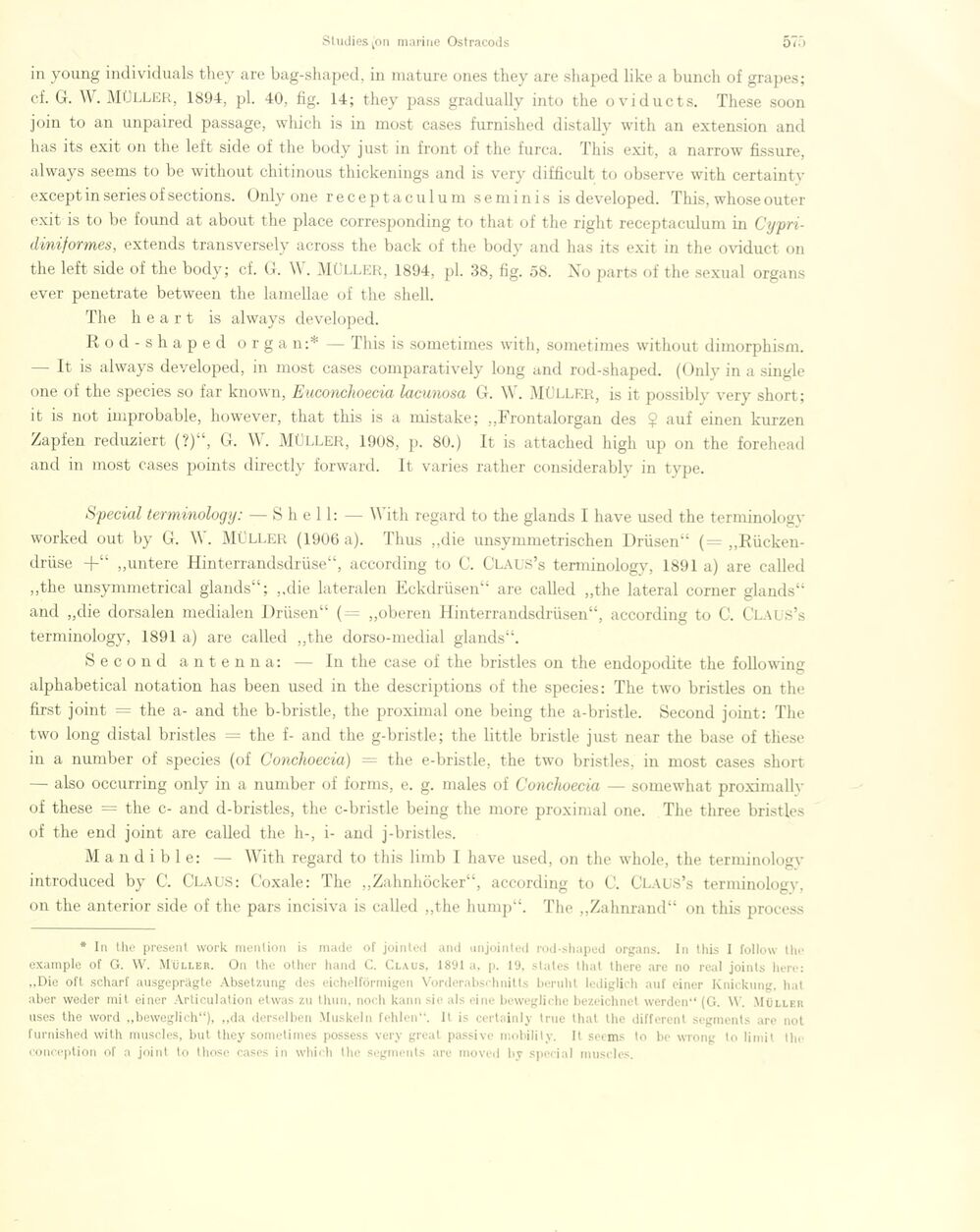
Full resolution (JPEG) - On this page / på denna sida - Sidor ...

<< prev. page << föreg. sida << >> nästa sida >> next page >>
Below is the raw OCR text
from the above scanned image.
Do you see an error? Proofread the page now!
Här nedan syns maskintolkade texten från faksimilbilden ovan.
Ser du något fel? Korrekturläs sidan nu!
This page has never been proofread. / Denna sida har aldrig korrekturlästs.
in young individuals tbey are bag-shaped, in mature ones they are sliaped like a buneh of grapes;
cf. G. W. Müller, 1894, pi. 40. fig. 14; they pass gradually into the o vi duets. These soon
join to an unpaired passage, which is in most cases furnished distally with an extension and
has its exit on the left side of the body just in front of the furca. This exit, a narrow fissure,
always seems to be without chitinous thickenings and is very difficult to observe with certainty
except in series of sections. Only one receptaculum se minis is developed. This, whose outer
exit is to be found at about the place corresponding to that of the right receptaculum in
Cypri-diniformes, extends transversely across the back of the body and has its exit in the oviduct on
the left side of the body; cf. G. \\ . MÜLLER, 1894, pi. 38, fig. 58. Xo parts of the sexual organs
ever penetrate between the lamellae of the sheik
The heart is always developed.
Rod-shaped organ:* — This is sometimes with, sometimes without dimorphism.
— It is always developed, in most cases comparatively long and rod-shaped. (Only in a single
one of the species so far known, Euconchoecia lacunosa G. W. Müller, is it possibly very short;
it is not improbable, however, that this is a mistake; „Frontalorgan des $ auf einen kurzen
Zapfen reduziert (?)“, G. W. MÜLLER, 1908, p. 80.) It is attached high up on the forehead
and in most cases points directly forward. It varies rather considerably in type.
Special terminology: — Shell: — With regard to the glands I have used the terminology
worked out by G. W. Müller (1906 a). Thus „die unsymmetrischen Drüsen“ (=
„Rückendrüse -f-“ „untere Hinterrandsdrüse“, according to C. Claus’s terminology, 1891 a) are called
„the unsymmetrical glands“; „die lateralen Eckdrüsen“ are called „the lateral corner glands“
and „die dorsalen medialen Drüsen“ (= „oberen Hinterrandsdrüsen“, according to C. Claus’s
terminology, 1891 a) are called „the dorso-medial glands“.
Second antenna: — In the case of the bristles on the endopodite the folio wing
alphabetical notation has been used in the descriptions of the species: The two bristles on the
first joint = the a- and the b-bristle, the proximal one being the a-bristle. Second joint: The
two long distal bristles = the f- and the g-bristle; the little bristle just near the base of tHese
in a number of species (of Conchoecia) — the e-bristle, the two bristles, in most cases short
— also occurring only in a number of forms, e. g. males of Conchoecia — somewhat proximali}’
of these = the c- and d-bristles, the c-bristle being the more proximal one. The three bristles
of the end joint are called the h-, i- and j-bristles.
M a n d i b 1 e: — With regard to this limb I have used, on the whole, the terminology
introduced by C. CLAUS: Coxale: The „Zahnhöcker“, according to C. Claus’s terminology,
on the anterior side of the pars incisiva is called „the hump“. The „Zahnrand“ on this process
* In the present work mention is made of jointed and unjointed rod-shaped organs. In this I follow the
example of G. W. Müller. On the other hånd C. Claus, 1891 a, p. 19, states that there are no real joints liere:
„Die oft scharf ausgeprägte Absetzung des eichelförmigen Vorderabschnitts beruht lediglich auf einer Knickung, hat
aber weder mit einer Articulation etwas zu thun. noch kann sie als eine bewegliche bezeichnet werden“ (G. W. Müller
uses the word „beweglich“), „da derselben Muskeln fehlen“. It is certainly true thai the different segments are not
furnished with muscles, but tliey sometimes possess very great passive mobility. It serins to be wrong to limit the
conception of a joint to those cases in which the segments arc moved by special muscles.
<< prev. page << föreg. sida << >> nästa sida >> next page >>